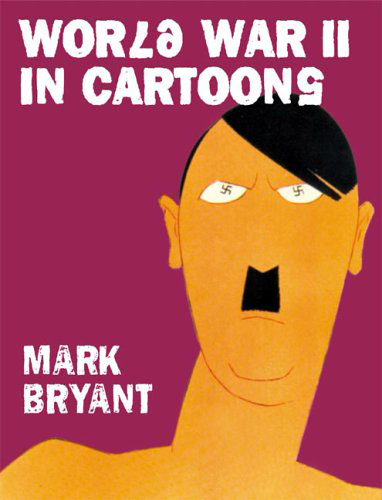Giving chase to my recent review of Mark Bryant’s look at the cartoons of World War I is this similar volume from him looking at the art of 1939-1945. In this volume you can see how styles progressed in Europe and beyond and while many of the trends influencing cartoonists can almost be divided along national lines we can see how things took fairly definite paths in Britain and the USA while there remains a strong traditionalist streak to a lot of the art from what Donald Rumsfeld once called old Europe
The British newspaper cartoons from this period, in particular work by David Low and Carl Giles affected a graphic style that had also found favour in the press in the US, Australia and beyond that persists to this day. Low was a genius without doubt, but for me growing up in the post war world, Carl Giles remains king of the hill. Collecting his annuals was one thing, but owning an original was beyond hope. His canvasses, cramming in an increasing amount of detail, with other stories played out in the background are pretty much in the masterpiece sphere of cartoon art.
The book brings us the work of the great Bill Maudlin, a name we can hardly ignore with his wonderful stories of the every day trials of the US soldier; a life he know all about. You cannot help but adore Mauldin’s work. As with the others, if the point of the punch line is a little hazy, you can guarantee that the art is exceptional.
The book looks wider afield to the sort of material coming from all the belligerents and they juxtapose in a somewhat awkward way as we see clearly how different national tastes and styles were. There are odd bits that you might say cross over, but there is something quite different about much of the material coming out of the Third Reich – the styles often looking back to an earlier war.
The propaganda element can be gentle or as subtle as a flying chainsaw. The message was the all-important thing and, once again, we see some iconic poster campaign art with deeply instilled slogans such as Careless talk costs lives, a catchphrase easily as well known as the recently en vogue Keep calm and carry on.
There are other iconic figures; the frequently undressed Jane from the Daily Mirror who found an international audience; the hapless plane wrecker Prune, Jon’s Two Type’s, while even Donald Duck himself found his way into uniform. Some of the most striking work is by Daniel Fitzpatrick of the St Louis Post-Dispatch, an artist who really nailed the horror and tragedy of the Third Reich as America destroyed it.
This is a magnificent book that fits perfectly with the previous volume on the Great War. I have to say I feel a lot more at home with the art here, but you can see from both how the messages of propaganda – encouraging or vitriolic – were fairly consistent.
Did cartoons help the Allies win the war? Who can say? They played a part on both sides in some form or another. Some artists found fame and fortune while others faded away.
The head of technical subjects at my sorry old school knew someone who knew someone who knew Carl Giles and a large image he made of a woodwork class hung in the tech block stairwell. I used to look at it almost every day, finding little things I’d missed each time and I often wonder what happened to it after the school was closed down many years ago.
Giles’ work is everywhere and rightly so. He caught the mood of the nation so well during World War II and like many of his contemporaries his art and humour live on. This is wonderful news for us because through this art we can define a great deal about the war you can’t get from dry prose or even photographs.
Cartoons add a dimension to the history of the war that is well worth investigating. A book like this gets us off to a good start.
Reviewed by Mark Barnes for War History Online
WORLD WAR II IN CARTOONS
By Mark Bryant
Grub Street
ISBN: 978 1 909808 11 9
